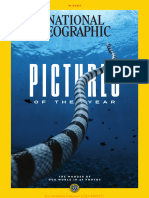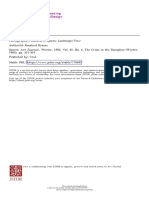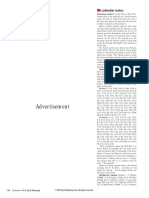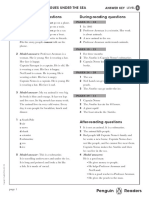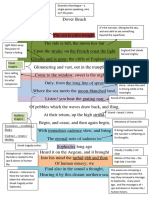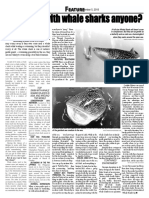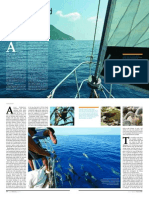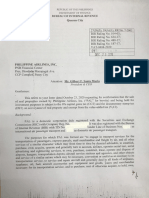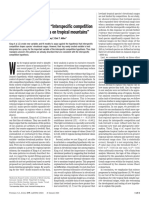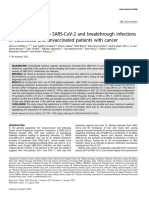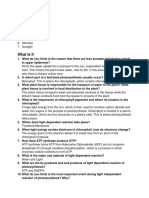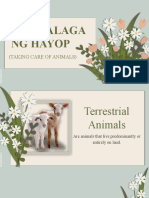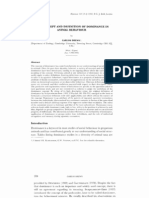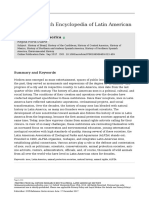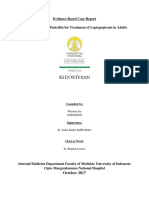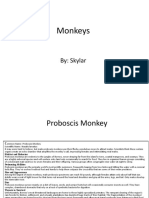A Riot of Hidden Life in The Arctic After Dark: Feature
A Riot of Hidden Life in The Arctic After Dark: Feature
Uploaded by
chato law officeCopyright:
Available Formats
A Riot of Hidden Life in The Arctic After Dark: Feature
A Riot of Hidden Life in The Arctic After Dark: Feature
Uploaded by
chato law officeOriginal Title
Copyright
Available Formats
Share this document
Did you find this document useful?
Is this content inappropriate?
Copyright:
Available Formats
A Riot of Hidden Life in The Arctic After Dark: Feature
A Riot of Hidden Life in The Arctic After Dark: Feature
Uploaded by
chato law officeCopyright:
Available Formats
Feature
RANDALL HYMAN
A RIOT OF HIDDEN T
The R/V Helmer Hanssen cruises near the archipelago of Svalbard, studying the impacts of light on residents of the Arctic Ocean.
he Northern Lights dance across the
horizon in emerald and lavender
ribbons as the R/V Helmer Hanssen
cruises through one of the darkest
LIFE IN THE ARCTIC
regions of the planet in the heart
of winter. For more than a dozen
researchers on this two-week
voyage, the mission is simple but
profound: to disappear.
AFTER DARK
Gliding through inky waters, our captain
suddenly shuts off every exterior light on
the ship and we become invisible, a maritime
phantom. It is the ideal way to study marine
organisms that exploit darkness and cold as
few other forms of life can.
This is a new frontier for Arctic researchers.
Until 2007, it wouldn’t have seemed profitable
An international team braved the far north in January to to stage an oceanographic biology expedition
unlock secrets of how marine organisms tell day from in midwinter. Scientists thought that most
of the region’s marine ecosystem shut down
night during the polar winter. By Randall Hyman throughout the months-long darkness of polar
night. Without sunlight to power the growth of
photosynthetic plankton, there would be noth-
ing to eat for the larger zooplankton, which are
the primary source of food for seabirds and fish.
That was the conventional wisdom, at least.
238 | Nature | Vol 616 | 13 April 2023
©
2
0
2
3
S
p
r
i
n
g
e
r
N
a
t
u
r
e
L
i
m
i
t
e
d
.
A
l
l
r
i
g
h
t
s
r
e
s
e
r
v
e
d
.
It turned out to be wrong. A series of A gentle bear of a man, Berge has a legendary physiology of these organisms in the pristine
discoveries has shown that even in the absence reputation among polar marine biologists. polar night, but we were removing the pristine
of sunlight and food, some zooplankton “The work by his team has really changed our part of it by coming with our big ship full of
thrive throughout the winter. They mate and perception of how the Arctic system operates,” white lights.”
incubate eggs in the darkness — and all that says aquatic ecologist Andrew Brierley at the With human-made artificial light generating
activity plays a crucial part in fuelling the Arc- University of St Andrews, UK, who has not more concern worldwide, understanding it
tic’s massive explosion of rebirth each spring. participated in Deep Impact. in the Arctic is becoming increasingly impor-
But researchers eventually recognized they “He has shown us that the notion of tant, say researchers. Although artificial light
had a problem: how to study the wintertime dormancy in the polar night is a myth, that remains scarce in the far north, it is growing as
exploits of ocean life that depends on dark- many biological processes continue, and, vanishing ice opens new shipping lanes and
ness. I joined this international team of scien- more importantly, that what humans perceive enables exploitation of the seabed for fossil
tists on its cruise in January as they tested new as dark is not a showstopper.” fuels and minerals. Deep Impact’s findings
ways to monitor ocean life in the Arctic night Nearly a decade after Berge’s first discov- are also informing scientists from Norway to
— without altering its behaviour. ery, he and his team had another epiphany Alaska, whose winter inventories of fish stocks
Researchers are eager to get answers, in this same fjord aboard Helmer Hanssen: might be skewed by the lights of their ships.
because the Arctic is changing rapidly. Over Marine biologist Jackie Grebmeier at the
the past four decades, the region has warmed “What humans University of Maryland Chesapeake Biologi-
nearly four times faster than the rest of the cal Laboratory in Solomons, who participated
planet1, and its winter coating of sea ice is
perceive as dark in a separate research voyage last year to the
thinning rapidly, which means there is less ice is not a showstopper.” North Pole, says the Deep Impact expeditions
throughout spring and summer. At the same are timely. “As the Arctic opens up, so will
time, the retreat of the ice pack has opened human impacts and artificial-light influence,”
routes for shipping, tourist cruises and coastal their methods for studying marine life were says Grebmeier. “The only way we’re going to
development that all add light pollution to the disrupting it. They noticed that the DVM they have some protection and forecast impacts is
region. The combined changes mean that were detecting from on board our ship was to have these real-time data that Jørgen and his
increasing levels of light are seeping into the significantly weaker than the one detected team are collecting.”
Arctic Ocean, even during winter, which could by automated instruments left unattended To do that, the Deep Impact team has come
forever alter the ecosystem that has evolved during the winter3. They wondered whether up with innovative solutions to the problems
to take advantage of the darkness. light was the reason. posed by the ships’ lights. During our expe-
“Organisms seek darkness,” says marine In 2016, bioacoustics specialist Maxime dition this year, Geoffroy and his colleagues
ecologist Jørgen Berge at UiT The Arctic Uni- Geoffroy drove a skiff as far from Helmer focus on both technology and biology by
versity of Norway in Tromsø, who has led a Hanssen as he dared, and flipped on his head- lowering nets and circular steel frames called
series of winter expeditions to this region lamp, aiming it straight into the black waters. rosettes, brimming with optical and acous-
aboard the Helmer Hanssen. He sees darkness He watched in amazement as an echosounder tic instruments, into the sea. These record
as a limiting ecological resource, similar to showed biomass instantly dispersing in all reactions of marine life in this remote Sval-
nutrients or oxygen. “And that is why artificial directions down to 80 metres, even in the weak bard fjord to a lights-off, lights-on protocol
light has such an impact,” he says. beam of a single headlamp. — successive passes with deck lights doused,
“It opened a whole can of worms,” says followed by more passes with lights glaring.
In the darkness Geoffroy, who works at the Memorial Univer- The fjord sits on the western edge of the
It was a chance discovery that set all this sity of Newfoundland in St John’s, Canada. island of Spitsbergen, near Ny-Ålesund, the
research in motion. In 2006, Berge visited the “What we were looking for at first was the northernmost village in the world that is
Svalbard archipelago, mountainous Norwe-
gian islands several hundred kilometres east
of Greenland’s northernmost coast, to moor
instruments in a fjord during the autumn. He
had to get the equipment in place before the
fjord’s waters froze in the winter, so he could
record the rebloom of life beneath the ice the
following spring.
But when he retrieved data from the moor-
ing the next year, he noticed a mysterious
pattern during winter. A sonar instrument
revealed that biomass in the fjord’s waters
dropped to lower depths during the day and
ascended towards the surface at night — a
signal that marine biologists call diel vertical
migration (DVM)2. But that shouldn’t have hap-
pened in the dead of polar night, when the Sun
doesn’t rise above the horizon.
“It was an accident, a complete surprise,” he
RANDALL HYMAN
recalls. Since then, Berge has led expeditions
nearly every year to Svalbard to follow up on
his discovery. He is principal investigator of
Deep Impact, a project funded by the Norwe- A cage known as AZKABAN is lowered into the water to study zooplankton and fish.
gian Research Council and run by UiT.
Nature | Vol 616 | 13 April 2023 | 239
©
2
0
2
3
S
p
r
i
n
g
e
r
N
a
t
u
r
e
L
i
m
i
t
e
d
.
A
l
l
r
i
g
h
t
s
r
e
s
e
r
v
e
d
.
Feature
occupied year-round. After we dock there dark, and is unsure of the accuracy of its GPS. Can creatures such as krill really sense the
briefly, several scientists remain aboard The craft suddenly materializes from the difference between high noon and sunset
Helmer Hanssen to continue their work, while dark. From her distant driver’s seat, Vena- during the polar night deep below the surface?
the other dozen scientists conduct experi- bles deftly turns the USV to run along our Cohen and Last suspect so, but have lacked a
ments at the village’s marine laboratory. hull, recording the varying depths of fleeing sufficiently sensitive marine light meter.
Small boats launch from the harbour with zooplankton while a drone flying overhead This year, they are testing an ultra-sensi-
instruments such as a marine light meter to photographs the watery halo of our illumina- tive commercial light meter developed with
track the rise and fall of daylight, invisible to tion. support from NASA. During the week, Cohen
human eyes in the heart of polar winter. Robotic “My heart was racing,” Venables confides submerges the sensor deep in the fjord, and
surface and submersible craft run tracks that evening as the team gathers for a meeting it detects natural light changes between day
behind Helmer Hanssen’s path using echo- at the marine lab. and night at depths of more than 40 metres.
sounders to record how the ship’s lights alter It is one of Deep Impact’s many experiments
biomass in the water. Rigged with a separate aimed at understanding the effect of artificial Disorienting darkness
echosounder, a large fish enclosure outside light on marine life and the dynamics of polar- Aboard the Helmer Hanssen, polar night is
the harbour records biological responses to night biology. disorienting for the crew and scientists. With
on–off cycles of a glaring spotlight. “Every year we come back, there’s new no sunrise, daytime becomes meaningless,
equipment and new needs based on work from and there is little to see out of the ship’s win-
Surface swerve the last year,” says Jonathan Cohen, a biolo- dows except blackness. As the days pass, a hint
Before making port at Ny-Ålesund, I stand atop gist at the University of Delaware in Lewes. of light glimmers low in the southern sky at
Helmer Hanssen’s bow to witness a high-stakes When I was aboard Helmer Hanssen in 2016, noon, but it is fleeting. At any hour, a handful
trial of a new method for tracking zooplank- his research on the eyes of shrimp-like animals of scientists work in the ship’s upper-deck
ton’s response to artificial light. Somewhere called krill determined that they are orders of instrument room, while others are stationed
in the darkness, not far off, a US$500,000 magnitude more sensitive in darkness than in a lower-deck wet lab.
unmanned surface vehicle (USV) is speeding are our own4. During deployment of nets and instruments
towards us. Its skipper, Emily Venables, sits He and marine biologist Kim Last at the in the lights-out mode, everyone in the wet lab
in a darkened room at the Ny-Ålesund marine Scottish Association for Marine Science in glows a ghostly red. Beyond the vault-like steel
lab several kilometres away, using a computer Oban, UK, are now exposing krill to faint door lies the raw Arctic. On a quiet windless
to pilot a boat-shaped icon on her screen — levels of blue-green wavelengths that mimic night, the Northern Lights shimmer above
straight for our port side. the natural daylight in the ocean, which blocks Svalbard’s barely visible snowy mountains.
The test is this season’s first attempt using red wavelengths below the surface. They want Scientists return each year for these magical
the USV to collect real-time data about how the to know whether polar night DVM is triggered moments, despite frozen fingers, seasickness
ship’s artificial light affects zooplankton in the by dim ambient light or an innate circadian and the risk of serious injury.
nearby waters. But Venables has tried piloting clock, and how artificial light might alter these During lights-on operations, Helmer Hans-
the robotic craft only a few times before in the behavioural responses. sen works like a conventional trawler as it
RANDALL HYMAN
The Northern Lights dance over the science village of Ny-Ålesund, where researchers on the Deep Impact project conducted some studies.
240 | Nature | Vol 616 | 13 April 2023
©
2
0
2
3
S
p
r
i
n
g
e
r
N
a
t
u
r
e
L
i
m
i
t
e
d
.
A
l
l
r
i
g
h
t
s
r
e
s
e
r
v
e
d
.
collects fish. Large nets and heavy cables drag
across icy decks over massive steel rollers,
threatening to snag careless researchers and
flip them down the stern’s slippery open ramp,
to be swallowed by black seas and churning
propellers.
One of the more unusual instrument
rosettes is called Frankenstein because of its
ungainly combinations of instruments, which
detect how light affects the vertical distribu-
tions of zooplankton and fish. Another, named
Fish Disco, emits sequences of multicoloured
flashes to measure how they affect the behav-
iour of zooplankton.
In the harbour by the marine lab on shore,
Muriel Dunn, one of Geoffroy’s PhD students,
is tracking how zooplankton and fish move
when they react to light. She is also using
machine learning to identify creatures by the
RANDALL HYMAN
pattern of the sound frequencies they reflect.
At the other end of the wharf, a construction
crane dangles a submerged, bus-sized steel
cage that is wrapped with nets to ensure that Jørgen Berge serves as principal investigator of the Deep Impact expeditions.
zooplankton and fish don’t escape as research-
ers test their reactions to light. the frigid waters of the marine lab harbour of RNA produced by planktonic organisms
In 2022, the cage held zooplankton samples. in a bulky ocean-survival suit. After an entire called dinoflagellates under moonlight and
Each time Dunn flipped on a large searchlight, day of testing connections, she is stumped. in complete darkness.
an acoustic sensor showed biomass fleeing The next day, the communications problems This year, they are focusing on Calanus
to the bottom of the cage, similar to what mysteriously vanish and the maiden voyage of glacialis, an endemic Arctic copepod and a
Geoffroy observed from a skiff in the open the LAUV is a success. Running in tandem with key species in the food web, to see whether
ocean years earlier. But the machine-learning the USV, the vessels show matching rise and fall there is a difference in RNA activity connected
algorithm was not able to identify species from of marine biomass as they thread their way past to Moon phases. Their experiment simulates a
the acoustic data. Helmer Hanssen. It is a step towards expanding shortened version of the Moon’s unusual cycle
This year, she’s back to try the approach the use of coordinated autonomous vehicles to in the polar night — it sits constantly above the
again using two species of cod — Atlantic study the ocean ecosystems. horizon around full phase, and is absent when
(Gadus morhua) and polar (Boreogadus saida). “We often talk about this observational it shows less than half. “Our hypothesis is that
When a timer on her laptop alerts her, she hur- pyramid, from satellites to drones to sur- somehow some Arctic species utilize moon-
ries across the wharf and climbs up into the face vehicles to underwater vehicles to sea light that other species can’t.”
cab of the crane to shut down the searchlight Results are pending, but if Hatlebakk is right,
shining on the cage of fish. Returning to the “We were removing the her research will help scientists to understand
shack, she is excited that the algorithm is able whether small changes in light — such as from
to discern between the two cod species.
pristine part of it by thinning of the pack ice and more light pol-
When Dunn and Geoffroy dismantle the coming with our big lution — could have big consequences in the
cage nets that evening, a storm kicks up, raking ship full of white lights.” Arctic, one of Deep Impact’s main questions.
the wharf with winds and salt spray. Working With this year’s experiments concluding, the
by the light of truck headlights, they are chilled land-based team begins packing up. Helmer
and soaked, but buoyed by the day’s data. floor,” says Berge. “I think that’s the future, Hanssen’s captain radios the marine lab to
More than storms hinder the research- with a much stronger focus on autonomous report that the on-board team has completed
ers’ plans. Working shoulder to shoulder in platforms.” its final lights-out transects in another fjord.
cramped labs and enduring the Arctic chill Before packing up for the season, research- The next morning, a one-hour break in heavy
aboard small boats, team members battle ers must finish a few more experiments in the winds allows our ship to dock, and the marine
various illnesses. Sore throats and coughs are marine lab at Ny-Ålesund. lab team scurries aboard as crates and cases
spreading, but still no COVID-19. “Something allows the more Arctic spe- are loaded by crane. Helmer Hanssen manages
Other problems stalk the expedition: engine cies to make it through the winter,” says Maja to pull away just as the winds worsen. We sail
trouble forced Helmer Hanssen back to main- Hatlebakk, a marine biologist at NTNU, as she due south through rough seas, towards the
land Norway at the start of our journey and inspects small crustaceans called copepods distant glow of daylight on the horizon.
nearly cancelled the cruise. And computer illuminated by dim, eerie light in a darkened,
gremlins are blocking radio communications refrigerated vault. Randall Hyman is a freelance journalist in
for the expedition’s submersible, a roughly For some of the southern species that come St Louis, Missouri, and was embedded with
2-metre long, torpedo-like craft called a light in with currents during summer, she says, the Deep Impact mission in January 2023 and
autonomous underwater vehicle (LAUV). “they can’t make it through the winter here. January 2016.
“I’ve tried everything,” says Karoline Barstein, We want to know why”.
1. Rantanen, M. et al. Commun. Earth Environ. 3, 168 (2022).
a PhD student in underwater robotics at the Last year, she and Ane Kvernvik, a marine 2. Berge, J. et al. Biol. Lett. 5, 69–72 (2009).
Norwegian University of Science and Technol- molecular ecologist at The University Centre 3. Ludvigsen, M. et al. Sci. Adv. 4, eaap9887 (2018).
ogy (NTNU) in Trondheim, as she wades from in Svalbard detected variations in the amount 4. Cohen, J. H. et al. PLoS Biol. 19, e3001413 (2021).
Nature | Vol 616 | 13 April 2023 | 241
©
2
0
2
3
S
p
r
i
n
g
e
r
N
a
t
u
r
e
L
i
m
i
t
e
d
.
A
l
l
r
i
g
h
t
s
r
e
s
e
r
v
e
d
.
You might also like
- Bir Form 1905 New VersionDocument4 pagesBir Form 1905 New Versionchato law office80% (5)
- Bir Form 1901 New VersionDocument4 pagesBir Form 1901 New Versionchato law office86% (7)
- Pyramid Guide n20 Nov-Dec 1975Document8 pagesPyramid Guide n20 Nov-Dec 1975Piuma Di FalcoNo ratings yet
- 2022revocation - ALPHA OMEGA WORLD DEVELOPMENT MARSHALL PROGRAMME INCDocument11 pages2022revocation - ALPHA OMEGA WORLD DEVELOPMENT MARSHALL PROGRAMME INCchato law officeNo ratings yet
- 2021-08-01 National Geographic InteractiveDocument136 pages2021-08-01 National Geographic InteractiveManolo Estuardo Ramirez100% (1)
- Cellsjw PDFDocument49 pagesCellsjw PDFToriNo ratings yet
- Laboratory Investigations in RheumatologyDocument43 pagesLaboratory Investigations in RheumatologyBahaa Shaaban100% (1)
- National Geographic USA - December 2023Document138 pagesNational Geographic USA - December 2023Tania Elena Melgoza CidNo ratings yet
- National Geographic Magazine UK - December 2023Document132 pagesNational Geographic Magazine UK - December 2023Guisella AbadNo ratings yet
- Folded Folded: The Future Is The Future IsDocument130 pagesFolded Folded: The Future Is The Future IsEdwin Singini100% (1)
- National Geographic USA December 2023Document136 pagesNational Geographic USA December 2023Omer NawazNo ratings yet
- National Geographic UK - September 2019-CompressedDocument133 pagesNational Geographic UK - September 2019-CompressedEmily Tan80% (5)
- National UK QWDQWDDocument134 pagesNational UK QWDQWDBrock Barnes100% (1)
- National Geographic USA - September 2019Document162 pagesNational Geographic USA - September 2019Crysis92100% (2)
- National Geographic UK - 02.2023Document124 pagesNational Geographic UK - 02.2023Ognjen Močevič100% (1)
- 26 12 2021 Delhi TH UxzDocument4 pages26 12 2021 Delhi TH UxzMrityunjay PathakNo ratings yet
- Comprehension - Setting New ZealandDocument2 pagesComprehension - Setting New Zealandbenji.pkaNo ratings yet
- Krauss - Photography's Discursive Spaces - Landscape-View - 1982Document10 pagesKrauss - Photography's Discursive Spaces - Landscape-View - 1982Noam GonnenNo ratings yet
- The Rime of The Ancient Mariner: What's InsideDocument23 pagesThe Rime of The Ancient Mariner: What's InsideAndreiStefanNo ratings yet
- Mocomi TimePass The Magazine - Issue 49Document15 pagesMocomi TimePass The Magazine - Issue 49Mocomi KidsNo ratings yet
- National Geographic UK November 2023Document126 pagesNational Geographic UK November 2023Dasha Balanchyk100% (1)
- Into THE Depths: Searching For Shipwrecks From Slavery's Hidden Past - To Help Heal The PresentDocument128 pagesInto THE Depths: Searching For Shipwrecks From Slavery's Hidden Past - To Help Heal The PresentMiguel Olmedo100% (1)
- TUGAS3 MANAJEMEN AKUAKULTUR Sari CahyatiDocument45 pagesTUGAS3 MANAJEMEN AKUAKULTUR Sari CahyatiSari CahyatiNo ratings yet
- Aquarium International 2012Document98 pagesAquarium International 2012laeucigasulNo ratings yet
- Lets Celebrate Mardi Gras by SlidesgoDocument55 pagesLets Celebrate Mardi Gras by Slidesgo2354030335thaoNo ratings yet
- World of Greyhawk Boxed Set (1e) - RemovedDocument84 pagesWorld of Greyhawk Boxed Set (1e) - RemovedFlávio ElóiNo ratings yet
- World of Greyhawk Boxed Set (TSR1015)Document140 pagesWorld of Greyhawk Boxed Set (TSR1015)Tony Martini100% (4)
- Advertisement: Calendar NotesDocument3 pagesAdvertisement: Calendar NotesDavor BatesNo ratings yet
- PR 20000 Leagues AnswerKeyDocument2 pagesPR 20000 Leagues AnswerKeyYamila PerezNo ratings yet
- Adventures in Rilleland: Lunar NotebookDocument2 pagesAdventures in Rilleland: Lunar NotebookDavor BatesNo ratings yet
- Eaten Fy Dana Lyne AndersenDocument52 pagesEaten Fy Dana Lyne AndersenNabhasvit HegdeNo ratings yet
- National Geographic UK - April 2022Document124 pagesNational Geographic UK - April 2022Hoa Thanh100% (2)
- National Geographic UK - July 2023Document138 pagesNational Geographic UK - July 2023Ognjen Močevič100% (2)
- World Ocean Day at School by SlidesgoDocument56 pagesWorld Ocean Day at School by SlidesgoSARAH LUCIA VILLANUEVA VALENZUELANo ratings yet
- Dover BeachDocument2 pagesDover Beachstudyingserious22No ratings yet
- National Geographic 2023 07Document148 pagesNational Geographic 2023 07Costis PavlouNo ratings yet
- Beautiful Ocean by SlidesgoDocument55 pagesBeautiful Ocean by SlidesgoAqilah Najla RofifahNo ratings yet
- Music8 Q4Document70 pagesMusic8 Q4ivylsolidarios17No ratings yet
- Halibut Herald December 17Document11 pagesHalibut Herald December 17EmeraldNo ratings yet
- National Geographic USA 2023-09Document140 pagesNational Geographic USA 2023-09Quang LeNo ratings yet
- Bài tập tài liệu 14Document5 pagesBài tập tài liệu 14Trần Thất BảoNo ratings yet
- The Land Mollusca of Nissan Solomon Islands: Paludinella Solomonensis N. SPDocument4 pagesThe Land Mollusca of Nissan Solomon Islands: Paludinella Solomonensis N. SPLukewarmNo ratings yet
- Summer 2020 EditDocument12 pagesSummer 2020 EdittrimNo ratings yet
- Alphabet for Kids InfographicsDocument28 pagesAlphabet for Kids Infographicsanderrodas5No ratings yet
- 19 Oracle's DecreeDocument2 pages19 Oracle's DecreeChris SNo ratings yet
- Geoglyphs To The Gods: Life, Death, Water and GeometryDocument6 pagesGeoglyphs To The Gods: Life, Death, Water and GeometrycrutiliNo ratings yet
- FinalscienceologyDocument7 pagesFinalscienceologyapi-327342629No ratings yet
- The High Energy UniverseDocument2 pagesThe High Energy UniversegrazynaNo ratings yet
- Swim With Whale SharksDocument1 pageSwim With Whale SharksEdmund GallanosaNo ratings yet
- Patterns in The Marine EnvironmentDocument20 pagesPatterns in The Marine EnvironmentJhon FredyNo ratings yet
- Q Plight-of-the-Polar-BearDocument11 pagesQ Plight-of-the-Polar-BearNatalia IlhanNo ratings yet
- Outlook NarcondamDocument4 pagesOutlook NarcondamAnandSinghNo ratings yet
- SampleDocument21 pagesSampleBloody SundayNo ratings yet
- Notebook Lesson XL Purple Variant by SlidesgoDocument85 pagesNotebook Lesson XL Purple Variant by SlidesgoJeremy Baker Jacobo VásquezNo ratings yet
- Unit 3 Vocab Two StarDocument1 pageUnit 3 Vocab Two StarArijus BalčiusNo ratings yet
- Chapter 2 - Interaction1 WritingDocument48 pagesChapter 2 - Interaction1 Writingbinhtr712No ratings yet
- Nature - January 11, 2018Document272 pagesNature - January 11, 2018Vaibhav Anand0% (1)
- Sharks Workbook enDocument13 pagesSharks Workbook enRaiza RaizaNo ratings yet
- Geography Class For Elementary - Canary Islands by SlidesgoDocument14 pagesGeography Class For Elementary - Canary Islands by SlidesgoKarol PaimaNo ratings yet
- Feature Article CompilationDocument21 pagesFeature Article Compilationabhiramjetty289No ratings yet
- Wonders Sea: of TheDocument12 pagesWonders Sea: of TheVanessa KingsNo ratings yet
- SucesionesDocument82 pagesSucesionesTamila TerukNo ratings yet
- Editorial Board - 2022 - Journal of Advanced ResearchDocument1 pageEditorial Board - 2022 - Journal of Advanced Researchchato law officeNo ratings yet
- Bir Form 1902 New VersionDocument2 pagesBir Form 1902 New Versionchato law officeNo ratings yet
- RMC No. 68-2023Document1 pageRMC No. 68-2023chato law officeNo ratings yet
- Ot 698 2020Document4 pagesOt 698 2020chato law officeNo ratings yet
- RMC No. 65-2023Document2 pagesRMC No. 65-2023chato law officeNo ratings yet
- Science Ade8043Document2 pagesScience Ade8043chato law officeNo ratings yet
- Bir Form 1904 New VersionDocument2 pagesBir Form 1904 New Versionchato law office100% (1)
- Natural Immunity To Sars-Cov-2 and Breakthrough Infections in Vaccinated and Unvaccinated Patients With CancerDocument6 pagesNatural Immunity To Sars-Cov-2 and Breakthrough Infections in Vaccinated and Unvaccinated Patients With Cancerchato law officeNo ratings yet
- NCBP2 and TFRC Are Novel Prognostic Biomarkers in Oral Squamous Cell CarcinomaDocument14 pagesNCBP2 and TFRC Are Novel Prognostic Biomarkers in Oral Squamous Cell Carcinomachato law officeNo ratings yet
- Glimmers of Hope For Targeting Oncogenic KRAS-G12D: Cancer Gene TherapyDocument3 pagesGlimmers of Hope For Targeting Oncogenic KRAS-G12D: Cancer Gene Therapychato law officeNo ratings yet
- Science Adg7879Document1 pageScience Adg7879chato law officeNo ratings yet
- BC 5150Document6 pagesBC 5150Ronan Colobong100% (2)
- Book Hurst Ventricular ElectrocardiographyDocument302 pagesBook Hurst Ventricular ElectrocardiographyNikos100% (2)
- Formative Assessment (Module 6)Document2 pagesFormative Assessment (Module 6)Keisha Gabrielle RabanoNo ratings yet
- 503 Resolution of The Cabinet of Ministers of The Republic of Azerbaijan-Pharmacovigilance-EnglishDocument19 pages503 Resolution of The Cabinet of Ministers of The Republic of Azerbaijan-Pharmacovigilance-EnglishFaisal Mohammed Shamim KhanNo ratings yet
- Monoclonal AntibodiesDocument16 pagesMonoclonal AntibodiesAndrei TatomirNo ratings yet
- Thyrocare, Sohrabh Hall, 112, A Wing, 1st Floor, Sangamwadi, Pune - 411 001Document9 pagesThyrocare, Sohrabh Hall, 112, A Wing, 1st Floor, Sangamwadi, Pune - 411 001AKSHAY GHADGENo ratings yet
- Chem Libretexts Org Textbook Maps Analytical Chemistry TextbDocument17 pagesChem Libretexts Org Textbook Maps Analytical Chemistry Textbshunmugam100% (2)
- English_B_paper_1__text_booklet_HL (1)Document8 pagesEnglish_B_paper_1__text_booklet_HL (1)Jiyun KimNo ratings yet
- Group 2 Pag Aalaga NG HayopDocument37 pagesGroup 2 Pag Aalaga NG HayopNinjaYoung FighterNo ratings yet
- Best Anti-Ageing Skincare Products: How To Opt For The Simplest Anti-Aging Wrinkle CreamDocument2 pagesBest Anti-Ageing Skincare Products: How To Opt For The Simplest Anti-Aging Wrinkle CreamaishwaryaNo ratings yet
- Community Ecology Community Ecology Looks at The InteractionsDocument5 pagesCommunity Ecology Community Ecology Looks at The InteractionsLeah MacalipayNo ratings yet
- Combined Enr Stat2000 2008Document301 pagesCombined Enr Stat2000 2008atguintuNo ratings yet
- Cambridge IGCSE: Biology 0610/21Document19 pagesCambridge IGCSE: Biology 0610/21Tuyền ChuNo ratings yet
- SOAL PTS B.ING KELAS 9 K13 - WEBSITE WWW - Kherysuryawan.idDocument7 pagesSOAL PTS B.ING KELAS 9 K13 - WEBSITE WWW - Kherysuryawan.idDarul muttaqinNo ratings yet
- The Concept and Definition of Dominance - Drews 1993Document31 pagesThe Concept and Definition of Dominance - Drews 1993cdrewsNo ratings yet
- Engr. Christylene S. BalagtasDocument7 pagesEngr. Christylene S. BalagtasIan PalenNo ratings yet
- Top Herbs and Botanicals For Antiaging PDF v2Document49 pagesTop Herbs and Botanicals For Antiaging PDF v2godolfintorent100% (2)
- HORTA, Regina - Zoos in Latin AmericaDocument21 pagesHORTA, Regina - Zoos in Latin AmericaAnonymous OeCloZYzNo ratings yet
- Handout Measurement Uncertainty TrainingDocument30 pagesHandout Measurement Uncertainty Trainingmaslinda aliasNo ratings yet
- Review General & USMLE Microbiology MCQsDocument51 pagesReview General & USMLE Microbiology MCQsM7md AllahhamNo ratings yet
- Evidence-Based Case Report Ceftriaxone Verus Penicillin For Treatment of Leptopspirosis in AdultsDocument7 pagesEvidence-Based Case Report Ceftriaxone Verus Penicillin For Treatment of Leptopspirosis in AdultsWinson JosNo ratings yet
- Monkeys: By: SkylarDocument15 pagesMonkeys: By: SkylarSkylar BarberNo ratings yet
- Ch1 Kitabcd Class 8 MSBHSE Science NotesDocument8 pagesCh1 Kitabcd Class 8 MSBHSE Science NotesONE CLICK COMPUTERNo ratings yet
- GoldBov - PriceListDocument2 pagesGoldBov - PriceListAgus SugiNo ratings yet
- DR - Ram Manohar Lohia National Law University, LucknowDocument10 pagesDR - Ram Manohar Lohia National Law University, LucknowUtkarsh KumarNo ratings yet
- Otot 2Document106 pagesOtot 2anita parwatiNo ratings yet
- Impact of Different Meadow Mowing Techniques On FiDocument9 pagesImpact of Different Meadow Mowing Techniques On FiSebastian IbronNo ratings yet
- The Impossible Voyage of Noah's Ark - NCSE PDFDocument28 pagesThe Impossible Voyage of Noah's Ark - NCSE PDFtonymontana2009No ratings yet










